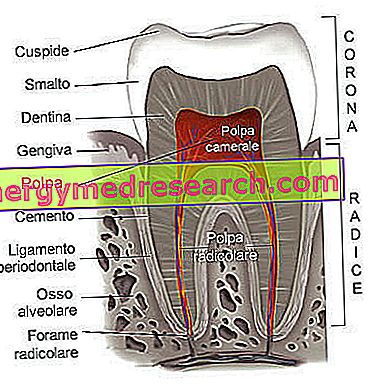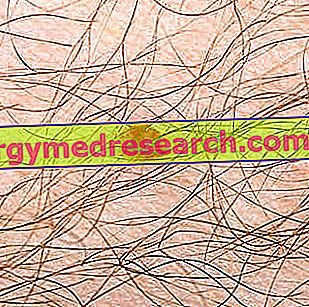Caries in brief: the key points
» Definition
Caries is a very slow dental infection, triggered by the attack of some microorganisms that populate the oral cavity.

» Symptoms
In the early stages, caries is asymptomatic. When the bacteria go deep, the carious process gives rise to disorders such as toothache, halitosis and dentinal hypersensitivity.
» Complications
Untreated cavities can lead to complications, such as pulpitis, dental abscess, dental cysts, dental granuloma, gingivitis and pyorrhea.
» Causes
Caries has a multifactorial origin. The infectious process is caused by exogenous factors (plaque deposition, incorrect nutrition, smoking) and endogenous factors (saliva reduction, tooth structure).
» Risk factors
Some factors may predispose to caries development. Among the most noteworthy are: infant / pubertal age, female sex, white race, wet climate, pregnancy and poor oral hygiene.
» Types of caries
There are many variations of caries. Among the most common, we remember: acute, chronic, recurrent, "dry or arrested" caries, central, senile, caries due to ionizing radiation, acid vapors and sugar workers.
» Care
Obturation is the treatment of choice for caries treatment. In the case of complicated caries associated with pulpits or granulomas, it is necessary to resort to devitalization or apicectomy. The extraction of the tooth is reserved for cases of extreme gravity, which cannot be rectified by the interventions just mentioned.
» Prevention
Caries prevention involves the meticulous and regular multi-daily oral hygiene, periodic checks by the dentist, a professional scaling every 6-12 months and the sealing of the molar teeth (as soon as the milk teeth fall to make room for the permanent ones).
Definition
Caries is a destructive process that affects the hard tissues of the tooth. It is a widespread disease and it is estimated that it affects, at least once in a lifetime, about 90% of the world population. The high social cost of caries has repercussions both on the pockets of the individual and those of the state.
Like all diseases, dental caries must not be underestimated: if neglected it can lead to the loss of several teeth and very serious infections.
Caries can affect men and other living beings without distinction; after death, the infection process stops.
Teeth affected by tooth decay
1) Third molar (wisdom tooth) 2) Second molar (12-year molar) 3) First molar (6-year molar) 4) Second premolar (2nd bicuspid) 5) First premolar (1st bicuspid) 6) Canine (cuspid) 7) Lateral incisor 8) Central incisor | 9) Central incisor 10) Lateral incisor 11) Canine (cuspid) 12) First premolar (1st bicuspid) 13) Second premolar (2nd bicuspid) 14) First molar (6-year molar) 15) Second molar (12-year molar) 16) Third molar (wisdom tooth) |
 | |
17) Third molar (wisdom tooth) 18) Second molar (12-year molar) 19) First molar (6-year molar) 20) Second premolar (2nd bicuspid) 21) First premolar (1st bicuspid) 22) Canino (Cuspide) 23) Lateral incisor 24) Central incisor | 25) Central incisor 26) Lateral incisor 27) Canine (cuspid) 28) First premolar (1st bicuspid) 29) Second premolar (2nd bicuspid) 60) First molar (6-year molar) 31) Second molar (12-year molar) 32) Third molar (wisdom tooth) |
Dental caries only affects the teeth exposed in the oral cavity, never those completely included * or completely isolated from the oral environment by a capsule (artificial * crown).
Dental caries can develop both in the teeth with intact dental pulp * and in those deprived of the pulp, which have therefore undergone an operation of devitalization *. Furthermore, caries can progressively destroy natural teeth, rootless teeth *, teeth embedded in a prosthesis and teeth without periodontal tissues *.
Dental caries more easily affects molars, premolars and upper incisors. In general it tends to develop between the interdental spaces where it is more difficult to remove food residues with a toothbrush. The accumulation and the stagnation of food between the intercuspid grooves (the kind of basin that forms between the 4 tips of the tooth) explains instead the greater predisposition of molars and premolars to the pathology.
Caries progression
Dental caries softens the hard tissues of the teeth which, only later, will be destroyed. Precisely, the carious process is the one and only dental infection capable of softening enamel * and dentin * before spoiling them. Radiographic examination of a carious tooth shows that the softening of hard tissues is essentially due to the progressive demineralization of the tooth.
We can distinguish the evolution of the carious process in two distinct phases:
- First phase (CARIE SURFICIALE): the carious process affects the enamel, the very hard external coating of the tooth, demineralizing it. The caries begins below the bacterial plaque, in some elective areas of the enamel. Initially, the caries presents a typical white-chalk, often brownish color. If in this phase it is neglected, the carious infection assumes a typical progressively increasing trend.
- Second phase (CARIE PENETRANTE): the acid products deriving from the fermentation of sugars are able to pierce the enamel, opening the way to the dentin. Once this second barrier has been overcome, the caries reaches the pulp, rich in vessels and nerve endings, causing the characteristic symptoms of the pathology. Let us briefly recall that in dentin the propagation of the cariogenic process is facilitated because, compared to the enamel, the tissue appears to be clearly less calcified. If caries were not treated even at this stage, the infection may evolve into different clinical forms (read: complications of dental infections).

The caries therefore propagates from the outside towards the inside of the dental element. It is a chronic disease with an extremely slow course: in most cases, the carious process evolves over a period of time ranging from 6 months to 2 years.
Caries cannot heal on its own: in fact, dental tissues do not have regenerative capacity. As we will see, the only solution to remedy the cariogenic process is obturation * (or in the most serious cases devitalization).
Glossary *
- Dental crown : section of the tooth that protrudes from the alveolar bone

- Teeth included : teeth partially or totally covered by the gum
- Dentin : very resistant bone tissue, located between dental enamel and pulp
- Devitalization : intervention that involves the removal of the dental pulp severely damaged by infection, trauma or extensive dental chipping
- Obturation : operation performed to restore teeth damaged by superficial or medium-sized caries
- Dental pulp : vital part of the tooth consisting of blood vessels, nerve endings and dentin-producing cells
- Dental root : section of the tooth inserted into the alveolar bone, inside which the dental pulp is contained
- Dental enamel: translucent white tissue, the most rigid and mineralized in the body
- Periodontal tissue: supporting apparatus of the tooth, consisting of gingiva, elastic connecting fibers and alveolar bone




